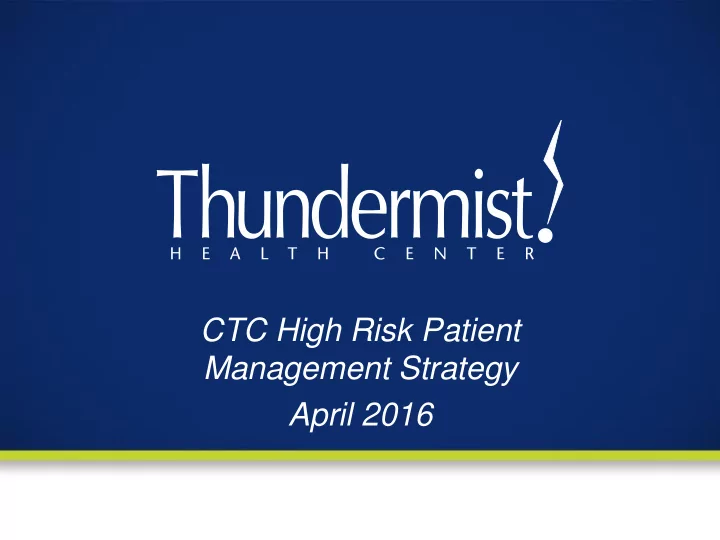

CTC High Risk Patient Management Strategy April 2016
Thundermist is: A Federally Qualified Community Health Center established in 1969 with sites in three Rhode Island communities – Woonsocket – West Warwick – South County 2
3
Patient Demographics 2015 Total Visits: 192,271 2015 Total Patients: 42,024 * Data from on 2015 UDS Report 4
CTC Advanced Collaborative Goal: reducing the total cost of care One approach: focus on high risk patients 5
High Risk Patients Who are high risk patients? It depends on who you ask. CTC Category #1 high cost/utilization CTC Category #2 poorly controlled complex patients CTC Category #3 payer defined and practice confirmed patient group 6
Category #1 High Cost/Utilization 3 or more emergency room visits in the last six (6) months and/or 3 or more hospitalizations in the last (6) months “I spent so much time going back and forth to the hospital, I bought an RV, and I’ll just live in the parking lot ” 7
Category #2 Poorly Controlled/Complex Patient Patients with 3 or more of the following chronic conditions: – Diabetes and the most recent HbA1c measurement is greater than 9 – Asthma – COPD – Hypertension (greater than 140/90 for ages 18- 59; greater than 150/90 for ages 60+) 8
Category #2 Poorly Controlled/Complex P atient cont’d. – CHF – Depression – Schizophrenia – Bi-polar disorder 9
Category #3 payer defined and practice confirmed patient group UnitedHealthcare: commercial and managed Medicaid Blue Cross Blue Shield : commercial and Medicare Advantage Tufts Health Plan : commercial NHPRI : managed Medicaid MAPCP : Medicare fee for service 10
CTC High Risk Distribution South County West Warwick Woonsocket 0 200 400 600 800 1000 1200 1400 Multiple Categories Only Plan ID High Risk Only Poor Control/Complex Only > 3 ED or IP 11
Nurse Care Manager Caseload for 4,435 Patients Woonsocket: 1701 (4 NCM’s) 425 / NCM West Warwick: 1770 (3 NCM’s) 590 / NCM South County: 691 (1 NCM) 691 / NCM 12
Provider Evaluation of Payer Identified High Risk Patients Providers thought that further efforts for many of these patients would not result in reduced cost or benefit to patient Some patients were one-time high cost (motorcycle accident) Some patients had high cost chronic conditions (cancer) ….Something is missing 13
“Impactable” Risk Algorithm Description Points 3+ ED or IP Visits 3 ED or IP Visits for BH 3 2+ No Shows 2 Homeless 2 Uninsured 2 HbA1C > 9 1 Poorly Controlled Asthma 1 Active Addiction Diagnosis 1 10+ Active Medications 1 Incomplete Referrals > 6 Months 1 BMI > 35 1 Active Smoker 1 Total Possible Points 19 Recognizes cumulative impact of health, utilization, behavior, and social factors that we can measure and supports structured allocation of resources to maximize impact. 14
“Impactability” Distribution 852 1694 pts. 733 1133 pts. 649 561 718 pts . 507 415 418pts. 300 167 61 39 26 13 0 2 1 2 3 4 5 6 7 8 9 10 11 12 13 14 "Impactability" Score 15
Intersection of Payer High Risk and “Impactability” “Impactability” Focus The number of Patients / NCM Score Greater than Population plan identified or equal to: patients > 4 1694 562 (33.2%) 221 > 5 1133 367 (32.4%) 142 > 6 718 213 (29.7%) 88 16
Impact Strategies Utilize existing resources for maximum impact (CHT, NCM, Social Service, BH, Tobacco Cessation, etc.) Match specific interventions for each “impactability” factor Maximize engagement through use of pre-visit planning and missed opportunity reporting (QI tools) Emphasize pre-existing relationships in case assignment process 17
Workflow for Patient Intervention Quarterly report with “Impactability” Score is divvied up into caseloads for NCMs, CHT workers, BH and SS staff. Caseloads assigned based on information gleaned from the high risk categories and “Impactability” items. – Staff actively outreach to the patients in their caseload. Daily pre-visit planning report is produced to identify any high risk patients with an “Impactability” Score of 4+ that are having a visit in the next week. – Staff with patients on this pre-visit planning report make plans to try and see the patient when they are on site for a visit. 18
Results 19
Recommend
More recommend